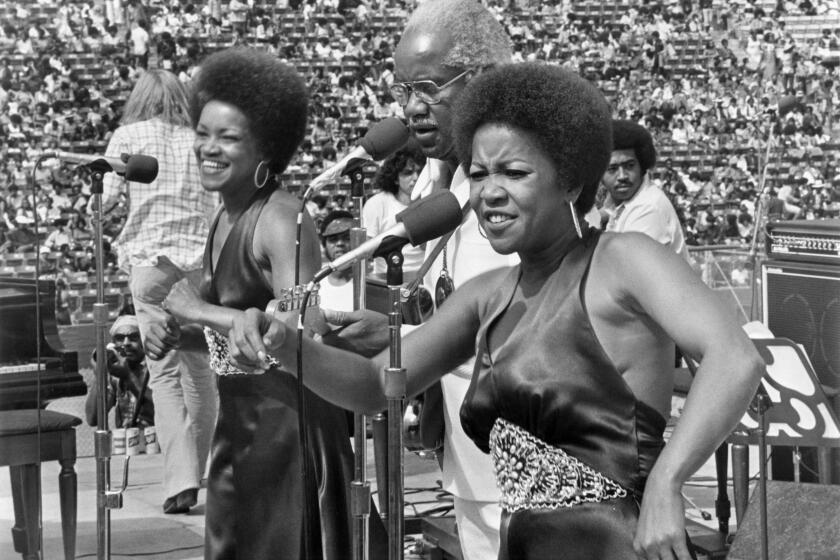Jim Stewart, co-founder of Memphis’ famed Stax Records, dies at 92

- Share via
Jim Stewart, the white Tennessee farm boy and fiddle player who co-founded the influential Stax Records with his sister in a Black inner-city Memphis neighborhood and helped build the soulful “Memphis sound,” has died at 92.
Stewart died peacefully and surrounded by his family on Monday, the Stax Museum of American Soul Music said in a news release. A cause of death was not disclosed.
Stewart was co-founder of Stax Records in Memphis, where, during an era of racial strife, white musicians and producers worked alongside Black singers, songwriters and instrumentalists to create the “Memphis sound” embodied by Otis Redding, Isaac Hayes, Booker T. and the M.G.s, Carla and Rufus Thomas, the Staple Singers, Wilson Pickett, Sam & Dave and many others.
Stax and its affiliated record labels released 300 albums and 800 singles between 1959 and 1975, according to the Rock and Roll Hall of Fame. Stax fostered a raw sound born from Black church music, the blues and rock ‘n’ roll. It featured strong rhythm sections, powerful horn players, and singers who could be sexy and soulful in one tune, and loud and forceful in another.
Before Stax went bankrupt in 1975, the recording studio in Memphis’ “Soulsville” neighborhood produced lasting hits such as Otis Redding’s “Dock of the Bay,” Eddie Floyd’s “Knock on Wood,” Sam & Dave’s “Hold On, I’m Comin’ ” and “Soul Man,” and “Green Onions” by Booker T. and the M.G.s.
“There was so much talent here, under circumstances that were almost considered impossible in Memphis, Tennessee, in 1960, with the racial situation here,” Stewart told the Associated Press in 2013. “It was a sanctuary for all of us to get away from the outside world.”
1973’s ‘Wattstax’ documents a musical moment in time for black Americans.
Stewart grew up on a farm in Middleton, Tenn., before moving to Memphis to attend Memphis State University and joining a group called the Canyon Cowboys as a country music fiddler. He was recording country music in his wife’s uncle’s garage and working at a bank when he and his sister, Estelle Axton, founded the Satellite record label in 1957.
In 1961, after learning of a California label with the same Satellite name, Stewart and Axton decided to combine the first two letters of their last names to create a new name, Stax. The pair moved the studio into an old movie theater in Memphis.
Soon, young musicians from the neighborhood started hanging around, helping Stax build a house band that included organist Booker T. Jones, guitarist Steve Cropper, bassist Donald “Duck” Dunn and drummer Al Jackson Jr. — also known as Booker T. and the M.G.s.
Stewart said he turned Stax into a soul and R&B label after hearing Ray Charles sing “What’d I Say.”
“I was converted, immediately,” Stewart said. “I had never heard anything like that before. It allowed me to expand from country into R&B, into jazz, into gospel, wrapped all in one. That’s what Stax is.”
Booker T. and the M.G.s were racially mixed, as were the Memphis Horns, which backed many of the Stax hits.
Stax signed a distribution deal with Atlantic Records and brought in the songwriting team of Isaac Hayes and David Porter. Stewart also hired Al Bell as Stax’s national sales director, and the label continued growing and producing more hits, such as “Who’s Making Love” by Johnny Taylor.
The first tragedy to hit the label came with the death of Redding and four members of his backup band, the Bar-Kays, in a plane crash in 1967. Then the assassination of civil rights leader Martin Luther King Jr. in April 1968 in Memphis led to unrest in the city.
In 1968, Stewart, Axton and Bell sold Stax to Gulf & Western in exchange for stock. Stewart and Bell repurchased the label in 1970.
Little remembered today, Wattstax — ‘the Black Woodstock’ — drew nearly 100,000 fans to the L.A. Coliseum for a day of Black pride and transcendent soul music.
Stax saw a few more successes in the early 1970s, including the release of The Staple Singers’ “I’ll Take You There” and the Wattstax concert in Los Angeles in 1972. But cash flow started to slow down, bills went unpaid and lawsuits were filed.
Stewart sold his share of Stax to Al Bell in 1972. Creditors forced Stax into involuntary bankruptcy in 1975, marking the death of Stewart’s brainchild.
“He was hurt,” Axton told the Commercial Appeal in 1989.
The studio was torn down in 1989. Since then, Stax has been rebuilt and reborn in the form of a museum, a music academy and a charter school.
Stewart, who mostly stayed out of the public eye after Stax stopped making music, was inducted into the Rock and Roll Hall of Fame in 2002.
In 2013, Stewart made a rare appearance at Stax, touring the museum before visiting with the teenage musicians who attend the Stax Music Academy. Stewart made a few other appearances at Stax after that, including in 2019 for a news conference to announce plans for the academy’s 20th anniversary.
“The music is still alive and that’s what’s great about it,” Stewart said during the 2013 tour. “I’m very proud of what they have done. It’s amazing to me.”
More to Read
Start your day right
Sign up for Essential California for the L.A. Times biggest news, features and recommendations in your inbox six days a week.
You may occasionally receive promotional content from the Los Angeles Times.







